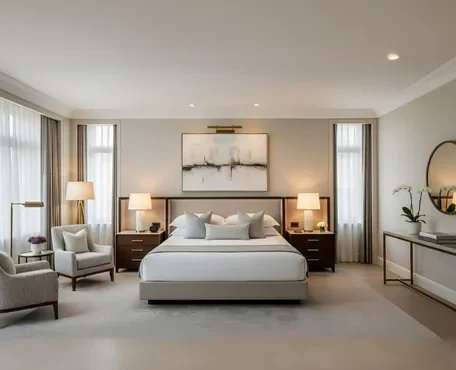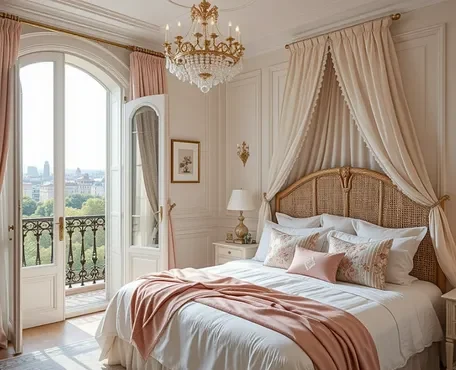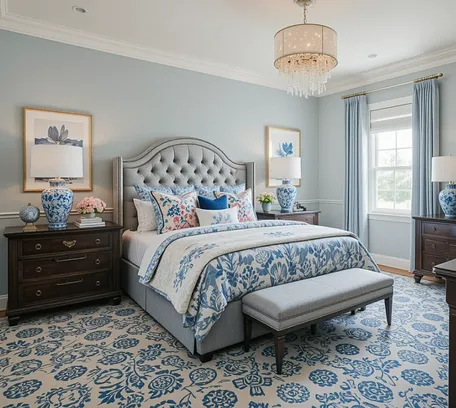

Ultimate Guide to Choosing the Perfect Bedroom Carpet
A bedroom is a sanctuary, a place where you start and end your day, and the flooring you choose can significantly impact the ambiance and comfort of this space. Among the plethora of flooring options available, carpets remain a popular choice for bedrooms, offering warmth, softness, and aesthetic appeal. However, selecting the right bedroom carpet involves considerations beyond just color and texture. From material and pile type to maintenance and budget, there are several factors to ponder . In this comprehensive guide, we delve into everything you need to know to choose the perfect bedroom carpet.
Here’s your ultimate guide to selecting the ideal carpet for your bedroom:

1.Consider the Style
Think about the overall style and ambiance you want to create in your bedroom. Are you aiming for a modern, minimalist look, or do you prefer a more traditional or cozy feel? The style of your carpet should complement the existing decor and furnishings in the room. When considering the style of your bedroom carpet, it’s crucial to align it with the overall ambiance you want to create in the space. Here’s how different carpet styles can complement various bedroom aesthetics:

Modern and Minimalist
For a modern and minimalist bedroom, opt for a carpet with clean lines, sleek textures, and neutral colors. Low-pile carpets like Berber or loop pile in shades of gray, beige, or white can enhance the minimalist aesthetic by providing a subtle foundation without overwhelming the space. Consider solid colors or subtle geometric patterns to add visual interest without detracting from the simplicity of the design.

Traditional and Cozy
If you prefer a more traditional or cozy feel in your bedroom, choose a carpet with a plush texture and warm, inviting colors. Soft, luxurious carpets like frieze or plush saxony in rich tones such as deep reds, warm browns, or earthy greens can create a cozy atmosphere reminiscent of classic comfort. Consider traditional patterns like floral or damask for a touch of elegance and charm that complements traditional furnishings and decor.

Viscose Carpet
Viscose carpet, also known as art silk or rayon carpet, is indeed valued for its softness and lustrous appearance. It’s often chosen for its resemblance to silk but at a more affordable price point. However, it’s important to note that viscose fibers can be sensitive to moisture and prone to flattening, so they may not be the best choice for high-traffic areas or spaces where spills are likely. Overall, though, they can add a touch of luxury to a room’s ambiance.

Persian carpets
Persian carpets are renowned worldwide for their intricate designs, vibrant colors, and exceptional craftsmanship. They have a rich history dating back thousands of years, with roots in ancient Persia (modern-day Iran). Persian carpets are traditionally hand-woven, often using techniques passed down through generations. Using Persian carpets in bedrooms adds elegance, warmth, and luxury. They offer comfort, aesthetic appeal, insulation, sound absorption, versatility, and cultural significance. Whether as a focal point or part of a layered look, they enhance the bedroom’s ambiance and style.

Eclectic and Bohemian
For an eclectic or bohemian bedroom style, embrace bold colors, vibrant patterns, and eclectic textures in your carpet choice. Consider layering rugs with different textures and patterns to add visual interest and personality to the space. Mix and match colors and patterns that reflect your unique style and personality, whether it’s a Moroccan-inspired rug with geometric motifs or a vintage Persian carpet with intricate designs.

Scandinavian and Hygge
Scandinavian and hygge-inspired bedrooms often feature light, airy spaces with a focus on comfort and coziness. Opt for a soft, plush carpet in light, neutral tones like white, cream, or light gray to enhance the sense of warmth and tranquility in the room. Consider natural materials like wool or jute for a tactile element that adds to the cozy ambiance. Layer sheepskin or faux fur rugs for extra warmth and texture, creating a hygge-inspired retreat that invites relaxation and comfort.
Ultimately, the style of your carpet should harmonize with the overall aesthetic of your bedroom, complementing existing decor and furnishings while enhancing the ambiance you want to create in the space. Whether you’re aiming for a modern, minimalist look, a traditional and cozy feel, or something more eclectic and bohemian, choosing the right carpet can help bring your vision to life and make your bedroom a comfortable and inviting sanctuary.

2.Think About Texture
The texture of the carpet can significantly impact the feel of the room. Plush, soft carpets like frieze or plush saxony are luxurious and comfortable underfoot, perfect for creating a cozy atmosphere. Alternatively, if you prefer a sleeker, more contemporary look, consider low-pile carpets like Berber or loop pile. Texture plays a crucial role in determining the overall look and feel of your bedroom carpet. Here’s how different textures can influence the ambiance of the space:
Plush and Soft
Plush, soft carpets like frieze or plush saxony are synonymous with luxury and comfort. These carpets feature long, twisted fibers that create a dense, cushioned surface underfoot. They’re perfect for bedrooms where comfort is a top priority, providing a cozy and inviting atmosphere that encourages relaxation. Plush carpets add warmth and softness to the room, making them ideal for creating a soothing retreat where you can sink your toes into luxurious comfort at the end of a long day.
Sleek and Contemporary
If you prefer a sleeker, more contemporary look in your bedroom, opt for low-pile carpets like Berber or loop pile. These carpets have shorter, tightly woven fibers that create a smooth, uniform surface with a modern aesthetic. Low-pile carpets are easy to maintain and clean, making them a practical choice for busy households. They also work well in bedrooms with minimalist or modern decor, providing a clean and streamlined look that complements sleek furnishings and decor elements.
Textured and Inviting
For a blend of comfort and contemporary style, consider textured carpets that offer a unique tactile experience. Cut and loop pile carpets feature a combination of cut fibers and looped fibers, creating interesting patterns and textures that add visual interest to the room. These carpets provide a balance of softness and durability, making them suitable for high-traffic areas like bedrooms. Textured carpets come in a variety of patterns and designs, allowing you to customize the look of your bedroom to suit your personal style and preferences.
Ultimately, the texture of your bedroom carpet should reflect your desired aesthetic and contribute to the overall ambiance of the space. Whether you prefer plush and soft for a cozy retreat, sleek and contemporary for a modern look, or textured and inviting for a blend of comfort and style, choosing the right texture can help create a bedroom that feels both stylish and welcoming.

3.Choose the Right Material
Carpets come in various materials, each with its own set of pros and cons. Wool carpets are durable, naturally stain-resistant, and have excellent insulation properties, making them a popular choice for bedrooms. Synthetic fibers like nylon and polyester are more affordable and offer a wide range of colors and styles. Consider your budget, lifestyle, and preferences when selecting the material. Selecting the right material for your bedroom carpet is essential for durability, comfort, and overall satisfaction. Here’s a closer look at some common carpet materials and their characteristics:
Wool
Wool carpets are prized for their natural durability, softness, and luxurious feel. They are naturally stain-resistant and have excellent insulation properties, making them ideal for bedrooms where comfort and longevity are priorities. Wool carpets are also hypoallergenic and resistant to mold and mildew, making them a healthy choice for allergy sufferers. While wool carpets tend to be more expensive upfront, their durability and longevity often make them a worthwhile investment in the long run.
Nylon
is one of the most popular synthetic carpet materials due to its durability, resilience, and versatility. Nylon carpets are highly resistant to wear and tear, making them suitable for high-traffic areas like bedrooms. They are also stain-resistant and easy to clean, making them a practical choice for busy households. Nylon carpets come in a wide range of colors and styles, allowing for customization to suit any decor aesthetic. While nylon carpets may be more affordable than wool, they can be prone to static electricity and may require anti-static treatments in dry climates.
Polyester
Polyester carpets are known for their softness, vibrant colors, and stain resistance. They are often more affordable than wool or nylon carpets, making them a budget-friendly option for bedroom flooring. Polyester fibers are naturally resistant to moisture, mold, and mildew, making them suitable for bedrooms with higher humidity levels. However, polyester carpets may not be as durable as wool or nylon and may show signs of wear and tear more quickly, especially in high-traffic areas.
When choosing the right material for your bedroom carpet, consider factors such as budget, lifestyle, and personal preferences. Wool carpets offer unparalleled durability and luxury but come with a higher price tag, while synthetic fibers like nylon and polyester provide affordability and versatility. Ultimately, selecting a carpet material that meets your needs and suits your lifestyle will ensure that your bedroom remains comfortable, stylish, and inviting for years to come.
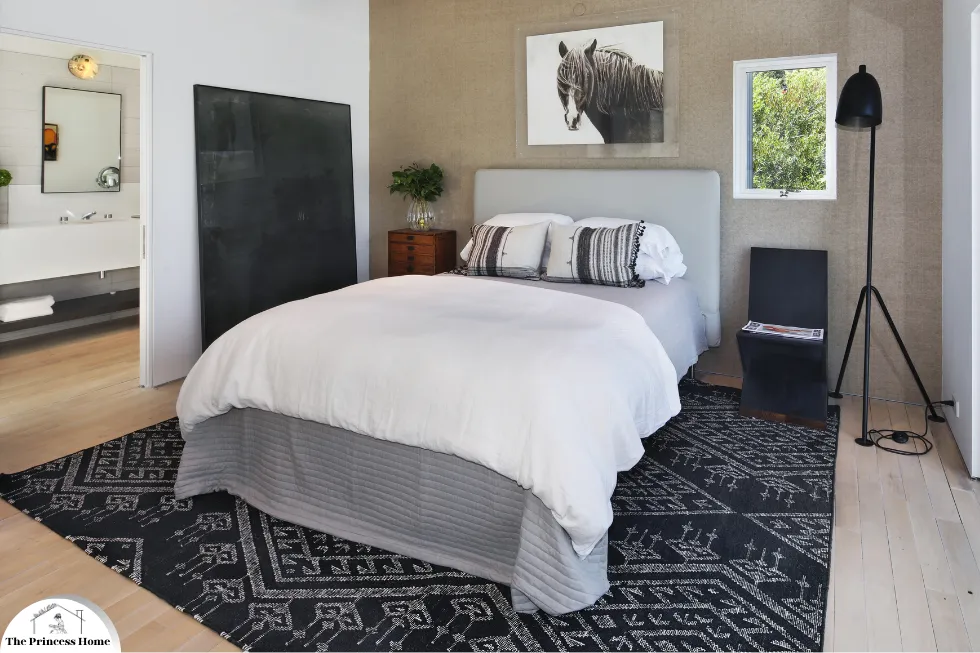
4.Consider Maintenance
Think about how much time and effort you’re willing to invest in maintaining your carpet. Some materials and textures are more prone to trapping dirt and debris and may require more frequent vacuuming or professional cleaning. Choose a carpet that suits your lifestyle and maintenance preferences. Considering maintenance is crucial when choosing a bedroom carpet, as it directly impacts the long-term upkeep and appearance of your flooring. Here are some points to consider:
Ease of Cleaning & Stain Resistance
Different carpet materials and textures require varying levels of maintenance. For example, low-pile carpets like Berber or loop pile are typically easier to clean and less prone to trapping dirt and debris compared to plush, high-pile carpets. Synthetic fibers such as nylon and polyester often resist stains better than natural materials like wool, making them easier to spot clean.
Some carpet materials are inherently more stain-resistant than others. Synthetic fibers like nylon and polyester often have built-in stain resistance or can be treated with stain-resistant coatings, making them easier to clean and maintain. Wool carpets, while naturally stain-resistant to some extent, may require additional treatments to protect against spills and stains.
Durability & Professional Cleaning
Consider the durability of the carpet material in relation to your lifestyle and the level of foot traffic in your bedroom. High-traffic areas may benefit from more durable carpet materials like nylon or wool, which can withstand wear and tear over time. Additionally, choose a carpet with a dense pile and tight weave to minimize matting and crushing in areas with heavy foot traffic.
Keep in mind that all carpets benefit from regular professional cleaning to remove deep-seated dirt, allergens, and stains. Factor in the cost and frequency of professional cleaning when choosing a carpet material and texture. Some materials may require more frequent professional cleaning to maintain their appearance and integrity.
Allergies and Sensitivities
If you or your family members have allergies or sensitivities, choose a carpet material that is hypoallergenic and resistant to mold, mildew, and dust mites. Synthetic fibers like nylon and polyester are less likely to harbor allergens compared to natural materials like wool, which may require more thorough cleaning to maintain indoor air quality.
Ultimately, the key to minimizing maintenance and maximizing the lifespan of your bedroom carpet is to choose a material and texture that aligns with your lifestyle, preferences, and maintenance habits. By selecting a carpet that is easy to clean, stain-resistant, and durable, you can enjoy a beautiful and comfortable bedroom space without the stress of constant upkeep.
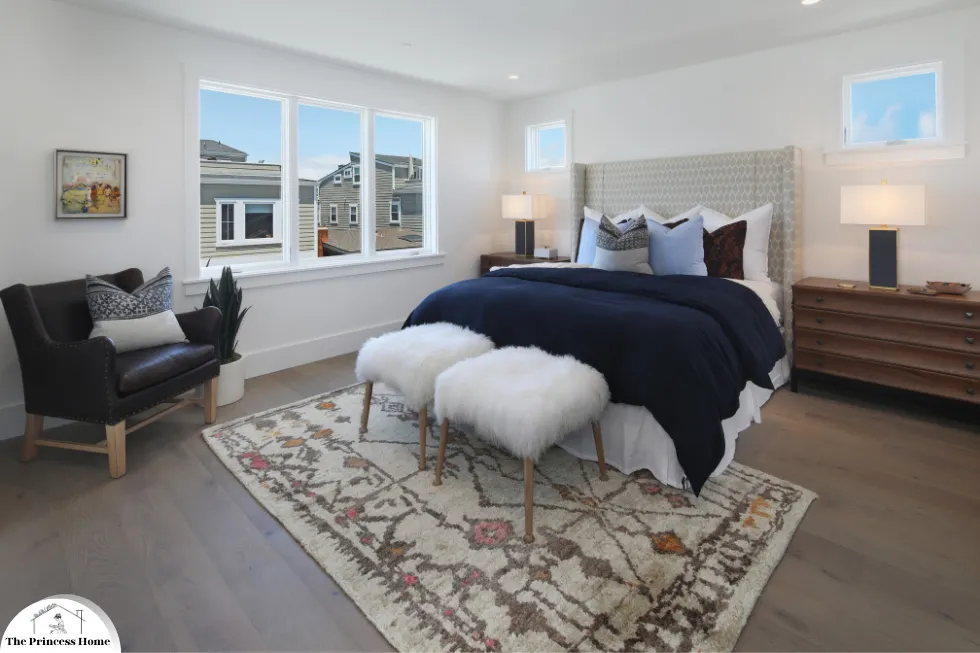
5.Color and Pattern
The color and pattern of your carpet can significantly impact the overall look and feel of your bedroom. Lighter colors can make a small room feel more spacious and airy, while darker colors can add warmth and coziness. Consider your existing decor and color scheme when selecting the color and pattern of your carpet. Indeed, the color and pattern of your bedroom carpet can have a profound effect on the ambiance and aesthetic of the space. Here are some considerations when choosing the right color and pattern for your bedroom carpet:
Room Size and Lighting
Lighter colors can make a small bedroom feel more spacious and airy by reflecting natural light and creating a sense of openness. If your bedroom is on the smaller side or lacks natural light, consider choosing a carpet in light shades such as white, cream, beige, or soft pastels to maximize the perceived space and brightness.
Coziness and Warmth
On the other hand, darker colors can add warmth and coziness to a bedroom, creating a more intimate and inviting atmosphere. Deep shades like charcoal gray, navy blue, or rich burgundy can anchor the room and provide a sense of comfort and security, especially in larger bedrooms or those with high ceilings.
Existing Decor & Color Scheme
Consider the existing decor and color scheme of your bedroom when selecting the color and pattern of your carpet. Choose a carpet color that complements the walls, furniture, bedding, and other decorative elements in the room. For a cohesive look, opt for a carpet that harmonizes with the dominant colors in your bedroom, whether they’re neutral tones, earthy hues, or vibrant accents.
Pattern Play
Patterns can add visual interest and personality to your bedroom carpet, whether you prefer subtle textures, geometric designs, or bold motifs. Consider your personal style and the overall aesthetic of your bedroom when choosing a pattern for your carpet. Small-scale patterns like herringbone or pin-dot can add texture without overwhelming the space, while larger patterns like floral or abstract designs can make a bold statement and serve as a focal point in the room.
Maintenance Considerations
Keep in mind that lighter colors and solid patterns may show stains and dirt more easily than darker colors or intricate patterns. If maintenance is a concern, choose a carpet with a pattern or texture that helps camouflage everyday wear and tear, or opt for a stain-resistant treatment for added protection.
Ultimately, the color and pattern of your bedroom carpet should reflect your personal style, enhance the overall aesthetic of the room, and create a harmonious and inviting space where you can relax and unwind. Whether you prefer light and airy or dark and cozy, choosing the right color and pattern can transform your bedroom into a sanctuary of comfort and style.

6.Think About Allergies
If you or your family members have allergies or sensitivities, consider choosing a carpet with hypoallergenic properties. Look for carpets made from natural materials like wool or those treated with anti-allergen treatments to minimize allergens and improve indoor air quality. considering allergies is crucial when selecting a carpet, especially for the bedroom where you spend a significant amount of time. Here’s how to choose a carpet that’s allergy-friendly:
Natural Materials & Anti-Allergen Treatments
Carpets made from natural materials like wool are often a good choice for allergy sufferers. Wool is naturally hypoallergenic, resistant to mold and mildew, and has inherent antimicrobial properties that can help minimize allergens in the home. Additionally, wool fibers trap dust and other allergens, keeping them out of the air you breathe.
Many carpet manufacturers offer anti-allergen treatments that can help reduce allergens and improve indoor air quality. These treatments may include special coatings or finishes that repel dust mites, mold, and mildew, making the carpet easier to clean and maintain. Look for carpets labeled as “anti-allergen” or “hypoallergenic” for added peace of mind.
Low VOC Emissions & Regular Cleaning
Volatile organic compounds (VOCs) emitted by carpet materials and adhesives can exacerbate allergies and respiratory issues. Choose carpets with low VOC emissions or those certified by third-party organizations like Green Label Plus or Floor Score, which test for indoor air quality and environmental sustainability. These certifications ensure that the carpet meets stringent standards for emissions and contributes to a healthier indoor environment.
Regardless of the type of carpet you choose, regular cleaning is essential for minimizing allergens and maintaining indoor air quality. Vacuum your carpet regularly using a high-efficiency particulate air (HEPA) filter vacuum cleaner to trap dust, pet dander, and other allergens. Consider steam cleaning or professional carpet cleaning periodically to remove embedded dirt and allergens from deep within the carpet fibers.
Allergy-Friendly Design
In addition to choosing an allergy-friendly carpet, consider other design elements that can help reduce allergens in the bedroom. Opt for smooth, washable surfaces for bedding, window treatments, and furniture upholstery to minimize dust accumulation. Use allergen-proof mattress and pillow covers to protect against dust mites and other allergens. Maintain proper humidity levels in the bedroom to prevent mold and mildew growth.
By choosing a carpet made from natural materials, treated with anti-allergen treatments, and certified for low VOC emissions, you can create a healthier indoor environment for you and your family, especially in the bedroom where you spend a significant amount of time resting and sleeping.
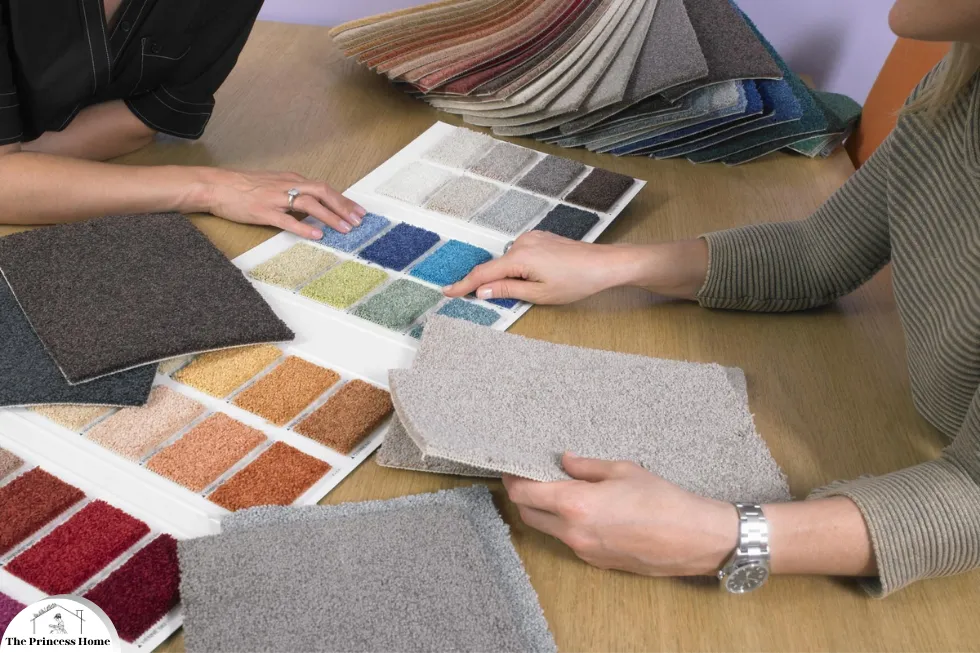
7.Test Samples
Before making a final decision, it’s a good idea to test out carpet samples in your bedroom to see how they look and feel in the space. Consider factors like lighting, room size, and existing decor when evaluating different options. Testing carpet samples in your bedroom is an excellent way to ensure that you select the perfect flooring for your space. Here’s how to make the most of your sample testing:
Obtain Samples &Evaluate Lighting
Start by obtaining samples of the carpet options you’re considering. Many carpet retailers offer sample swatches or small carpet squares that you can take home to test in your space. If possible, try to obtain samples that are large enough to give you a good sense of how the carpet will look and feel in your bedroom. Take note of the lighting conditions in your bedroom throughout the day. Natural light, artificial light sources, and the direction of light can all affect how colors appear in the space. Test your carpet samples under different lighting conditions to see how they look during various times of the day and night.
Consider Room Size & Match with Decor
Consider the size and layout of your bedroom when testing carpet samples. A large-scale pattern or bold color may overwhelm a small bedroom, while a subtle texture or neutral tone may make the space feel more expansive. Test samples in different areas of the room to see how they impact the overall visual perception of size and scale. Pay attention to how the carpet samples coordinate with your existing decor and furnishings. Consider the color, style, and texture of your furniture, bedding, wall paint, and other decorative elements in the room. Choose a carpet that complements the existing decor and enhances the overall aesthetic of the space.
Feel the Texture & Visualize the Final Look
Don’t forget to physically touch and feel the carpet samples to assess their texture and softness underfoot. Walk on the samples barefoot to experience how they feel and whether they provide the comfort and coziness you desire in a bedroom carpet. Consider how the texture of the carpet will interact with your daily activities, such as walking, sitting, and lounging in the bedroom.
Use the carpet samples to visualize how each option will look once installed in your bedroom. Imagine how the color, pattern, and texture of the carpet will contribute to the overall ambiance and style of the space. Take your time to compare and contrast different samples until you find the perfect carpet that meets your aesthetic preferences and practical needs.
By testing carpet samples in your bedroom and considering factors like lighting, room size, existing decor, and texture, you can make an informed decision and choose the perfect flooring that enhances the beauty and comfort of your space.
Here are some frequently asked questions related to the article :
1. What is the best type of carpet for a bedroom?
The best type of carpet for a bedroom depends on your preferences, budget, and lifestyle. Nylon carpets are known for their durability, while wool carpets offer luxurious softness and natural insulation. Polyester and polypropylene carpets are more budget-friendly options with varying levels of durability and comfort.
2. How do I choose the right color and pattern for my bedroom carpet?
When choosing the color and pattern of your bedroom carpet, consider the size of the room, existing decor, and personal preferences. Light-colored carpets can make small rooms feel more spacious, while dark colors add warmth and coziness. Patterns can add visual interest and complement your decor style, whether you prefer subtle designs or bold motifs.
3. How do I maintain and clean my bedroom carpet?
Regular vacuuming is essential to remove dirt, dust, and debris from your bedroom carpet. Promptly attend to spills and stains by blotting them with a clean cloth and using a mild detergent or carpet cleaner as needed. Schedule professional carpet cleaning every 12 to 18 months to remove deep-seated dirt and allergens, using methods like steam cleaning (hot water extraction) for optimal results.
4. Can I install a bedroom carpet myself, or do I need professional help?
While it’s possible to install a bedroom carpet yourself with the right tools and knowledge, professional installation is often recommended to ensure a proper fit and finish. Professional installers have the expertise to handle tricky corners and seams, as well as the necessary equipment for stretching and securing the carpet properly. However, if you have experience with carpet installation and feel confident in your abilities, DIY installation can be a cost-effective option.
5. How long can I expect my bedroom carpet to last?
The lifespan of a bedroom carpet depends on various factors, including the quality of the carpet, the material used, maintenance practices, and the level of foot traffic. High-quality carpets made from durable materials like nylon or wool can last 10 years or more with proper care. However, less durable materials like polyester or polypropylene may have a shorter lifespan. Regular maintenance, such as vacuuming and professional cleaning, can help extend the life of your bedroom carpet.



